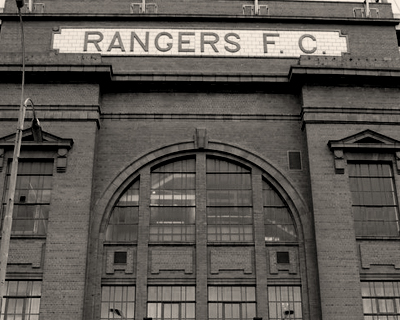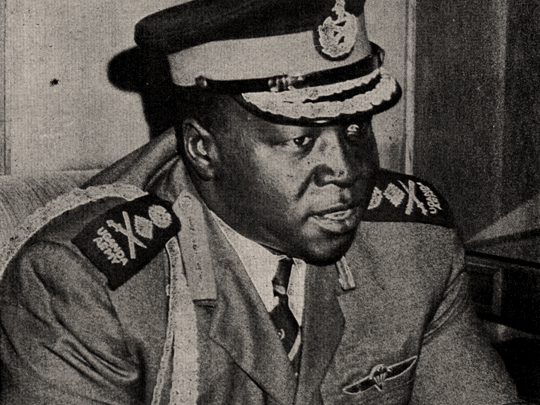Wikimedia Commons / CC-BY-SA-3.0 / GFDL
1 – General Idi Amin Dada Came to Power in Uganda After a Coup
In 1970, a rift developed between General Idi Amin and Ugandan Prime Minister Milton Obote, leading to a struggle for power.
It was inflamed by the support Amin had built within the army, his involvement in supporting a southern Sudanese rebellion and an attempt on Obote’s life in 1969.
After Obote took control of the armed forces in October 1970, it reduced Amin from his post of commander of all the armed forces to commander of the army.
Amin then learned Obote was planning to arrest him for misappropriating army funds, and seized power in a military coup on 25 January 1971, while Obote was at a Commonwealth summit in Singapore.
Troops loyal to Amin sealed off Entebbe International Airport, surrounded Obote’s residence and blocked major roads.
On 2 February 1971, Amin declared himself President of Uganda, Commander-in-Chief of the Armed Forces, amongst other titles.
He suspended some provisions of the Ugandan constitution and instituted an Advisory Defence Council with himself as the chairman.
Amin put military tribunals above the system of civil law and informed the newly inducted civilian cabinet ministers that they would be subject to military discipline.
Amin’s rule went on to be characterized by human rights abuses, repression, persecution, extrajudicial killings, corruption, and gross economic mismanagement.
The number of people killed as a result of his regime is estimated by international observers and human rights groups to range from 100,000 to 500,000.
In 1978, Amin’s attempt to annex the Kagera Region of Tanzania led to the Uganda–Tanzania War and the demise of his eight-year regime.
Amin then went into exile, first in Libya and then in Saudi Arabia, where he lived until his death on 16 August 2003.
2 – Robert Curtis Becomes the First British Soldier to be Killed During ‘the troubles’ in Northern Ireland
Following instances of major violence in many Irish republican areas of Belfast during the first week of February 1971, the British Army launched a series of searches for IRA arms.
Rioting in the Republican area of the New Lodge escalated and reinforcements were called for, and 156 Battery was ordered into the area.
A large crowd of rioters gathered at the junction and a troop of soldiers from 156 Battery, including Gunner Rob Curtis, were deployed to disperse the crowd.
As the troop moved to the junction they were attacked with a barrage of stones and bottles by the mob. A nail bomb was then thrown at the troop.
In the wake of the blast, the crowd split which allowed a gunman to fire at the Battery. The crowd then reformed, allowing the gunman to escape.
Gunner Curtis was hit by a ricochet passing through the opening of his flak jacket, penetrating his heart. He died almost instantly.
Four other troop members were wounded. He was the first officially recognized fatality that the British army suffered as a direct result of IRA actions.
3 – Apollo 15 Astronauts Take 6½ Hour Electric Car Ride on the Moon

Apollo 15 was the ninth manned mission in the USA’s Apollo program, the fourth to land on the Moon, and the eighth successful manned mission. It was the first mission during which the Lunar Roving Vehicle was used.
The mission began on July 26, 1971, and ended on August 7. At the time, NASA called it the most successful manned flight ever achieved.
Commander David Scott and Lunar Module Pilot James Irwin spent three days on the Moon, including 18 and a half hours outside the spacecraft on lunar extra-vehicular activity (EVA).
Scott and Irwin became the seventh and eighth humans to walk on the Moon. The first EVA lasted about 6½ hours.
In total, the two astronauts spent 18 and a half hours outside the Lunar Module and collected approx. 77 kg of lunar samples.
Upon re-entering, one of the three parachutes on the Command Module failed to deploy properly, however, only two were required for a safe landing.
After landing in the North Pacific, the crew was taken aboard the USS Okinawa after a mission lasting 12 days, 7 hours, 11 minutes, and 53 seconds.
4 – 66 Killed After a Barrier Collapses at Ibrox, Glasgow, During a Football Match

The disaster occurred on January 2, 1971, when 66 people were killed in a crush, as supporters tried to leave the stadium.
The match was an Old Firm game between Glasgow Rangers & Glasgow Celtic, attended by more than 80,000 fans.
In the 90th minute, Celtic took a 1–0 lead and some Rangers supporters started to leave the stadium. However, in the final moments of the match, Colin Stein scored an equalizer for Rangers.
As thousands of spectators were leaving the ground by a stairway, it appears that someone, possibly a child being carried on his father’s shoulders, fell, causing a massive chain-reaction pile-up of people.
This resulted in 66 deaths and more than 200 injuries. It was the worst British football disaster until the Hillsborough disaster in Sheffield, England, in 1989.
The stadium’s owners, Rangers FC, were later ruled to be at fault in a sheriff’s judgment on one of the deaths.
Rangers did not dispute this ruling and were sued for damages in 60 other cases brought by relatives of the dead.
5 – Indo-Pakistani War of 1971
The Indo-Pakistani War of 1971 was a military confrontation between India and Pakistan that started from the liberation war in East Pakistan on December 3 and ended with the Fall of Dhaka on December 16.
The war began with preemptive aerial strikes on 11 Indian air stations that led to the start of hostilities with Pakistan, and Indian entry into the war of independence in East Pakistan on the side of Bengali nationalist forces.
It is one of the shortest wars in history, lasting only 13 days, with Indian and Pakistani militaries clashing on both the eastern and western fronts.
The war ended after the Eastern Command of Pakistan military signed the Instrument of Surrender, on 16 December in Dhaka, marking the formation of East Pakistan as the new nation of Bangladesh.
Officially, East Pakistan had earlier called for its secession from Pakistan on 26 March 1971. Approx. 90,000 Pakistani servicemen were taken prisoners by the Indian Army.
It is estimated that between 300,000 and 3,000,000 civilians were killed in Bangladesh, with a further eight to ten million people fled the country at the time to seek refuge in neighboring India.









